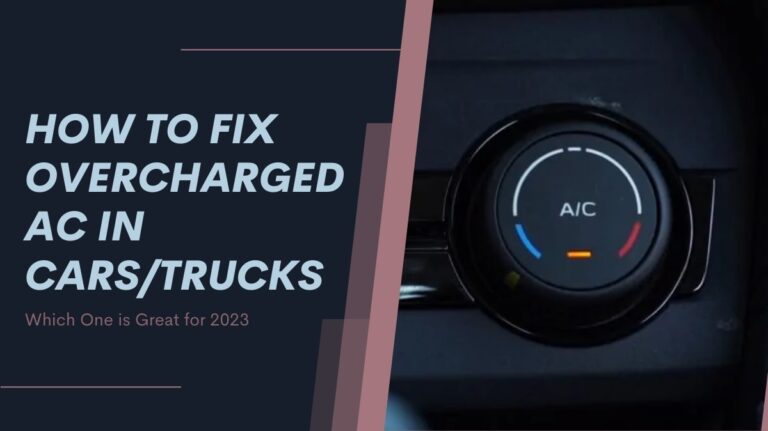To discharge car AC at home, gather necessary tools and equipment, locate the AC service ports, connect the AC gauge manifold set, and release the refrigerant properly following safety precautions. Discharging car AC at home involves a few simple steps that can be done with the right tools and knowledge.
By following a step-by-step guide, you can safely and effectively discharge your car’s AC system without the need for a professional mechanic. This process can help you save on repair costs and improve your understanding of your vehicle’s AC system.
Read on to learn how to discharge your car AC at home efficiently and safely.

Credit: www.youtube.com
Importance Of Discharging Car Ac
The importance of discharging car AC cannot be overlooked. Discharging the AC system is a crucial step in its maintenance that can save you both time and money in the long run. By following a step-by-step guide, you can ensure that your car’s AC is working optimally and avoid expensive repairs. Discharging the car AC regularly helps in troubleshooting AC issues and prevents the need for frequent repairs. It also allows you to identify and resolve any potential problems before they become major issues that could potentially lead to costly repairs.
Saving Money On Repairs
When it comes to car repairs, prevention is always better than cure. By discharging the car AC regularly, you can prevent damage to the system that could lead to expensive repairs down the line. Regularly discharging the AC system helps in reducing the strain on the components, ensuring they work efficiently and don’t wear out prematurely. This simple maintenance step can save you from the hassle and cost of replacing major components of the AC system.
Additionally, by discharging the car AC at home, you can save money that would otherwise be spent on professional services. Most car repair shops charge a significant amount for AC system diagnostics and repairs. By learning how to discharge the AC system yourself, you can avoid these expenses and take control of your car’s maintenance needs.
Troubleshooting Ac Issues
Discharging the car AC is an essential step in troubleshooting any issues you may be experiencing with the system. It allows you to assess the refrigerant levels, check for leaks, and identify any potential malfunctions. By following a step-by-step guide, you can take a proactive approach to preventing and resolving AC problems.
Regularly discharging the AC system also ensures that it is free from any contaminants that may affect its performance. Build-up of dirt, debris, or moisture can lead to reduced cooling capacity and increased strain on the AC components. By discharging the system, you can remove these contaminants and ensure that your AC runs smoothly and efficiently.
In conclusion, discharging your car’s AC at home is an important maintenance task that can help you save money on repairs and troubleshoot potential issues. By following a step-by-step guide, you can take control of your car’s AC system and ensure its optimal performance.

Credit: www.youtube.com
Preparations
Before you start the process of discharging your car AC, it’s essential to make adequate preparations. This will ensure a smooth and safe procedure. Here are the key steps you need to take to prepare for discharging your car AC at home.
Gathering Necessary Tools
One of the first things you need to do is to gather all the necessary tools and equipment required for discharging your car AC. Below is a list of essential tools you will need:
- AC Reclaimer Kit: An AC reclaimer kit is essential for safely recovering and recycling the refrigerant from your car’s AC system.
- Safety Glasses: It is important to wear safety glasses to protect your eyes from potential refrigerant leaks or splashes.
- Gloves: Wearing gloves will help protect your hands from any chemicals or refrigerant during the discharging process.
- Face Mask: A face mask will help prevent you from inhaling any harmful fumes or particles during the process.
- Work Gloves: It’s important to wear work gloves to protect your hands from any sharp edges or hot components in the AC system.
- Container: You will need a suitable container to collect the recovered refrigerant safely.
Choosing The Right Location
When discharging your car AC, it’s important to choose the right location to perform the task. Here are a few key considerations for choosing the right location:
- Well-Ventilated Area: Select a well-ventilated area to prevent the buildup of hazardous fumes or gases during the discharging process.
- Flat and Stable Surface: Ensure that you have a flat and stable surface to work on to avoid any accidents or spills.
- Avoiding Confined Spaces: Avoid working in confined spaces to allow for easy movement and ventilation.
- Safe Disposal: Have a plan for the safe disposal of the recovered refrigerant and any other waste materials generated during the process.
Step 1: Safety Precautions
Before attempting to discharge your car’s AC system at home, it is crucial to prioritize safety precautions.
Working In A Well-ventilated Area
Ensure you are working in an area with proper ventilation to prevent inhalation of harmful refrigerants.
Wearing Protective Gear
Don’t forget to wear appropriate protective gear such as safety goggles and gloves to shield yourself during the process.
Step 2: Locating The Ac System
Identifying Ac Components
Begin by identifying the key components of your car’s AC system. Look for the compressor, condenser, evaporator, and the refrigerant lines.
Understanding Ac System Layout
Understand the layout of the AC system to effectively locate it in your vehicle. The AC components are typically distributed throughout the engine compartment.
Step 3: Discharging The Ac
When it comes to discharging your car’s AC system, it’s crucial to follow the appropriate steps to ensure a safe and effective process. Step 3 involves discharging the AC refrigerant, and it’s important to perform this task in a precise manner to prevent any potential hazards.
Using An Ac Discharging Kit
To discharge the AC refrigerant, you can utilize an AC discharging kit, which includes the necessary components for this process. The kit typically consists of a pressure gauge, hoses, and valves that enable you to safely remove the refrigerant from the system.
Following Proper Discharging Procedure
Before initiating the discharging procedure, it’s essential to wear protective gear, such as safety goggles and gloves, to safeguard yourself from any potential exposure to the refrigerant. Additionally, ensure that the car is parked in a well-ventilated area to prevent the accumulation of fumes.

Credit: www.thompsontoyota.com
Step 4: Safely Handling Refrigerant Discharge
Safely handle refrigerant discharge when discharging car AC at home by following proper guidelines to ensure safety during the process. It is important to take necessary precautions and use the right tools to protect yourself and the environment from any potential harm.
When it comes to discharging your car’s AC system at home, it’s crucial to follow the necessary safety precautions. Handling refrigerant can be dangerous both for the environment and for you if not done correctly. In this step, we will discuss how to prevent environmental damage and avoid personal injuries while discharging the refrigerant from your car’s AC system.Preventing Environmental Damage
Discharging car AC refrigerant improperly can have a detrimental impact on the environment. Refrigerants contain harmful chemicals that can contribute to ozone depletion and climate change. To prevent environmental damage, follow these steps:- Use a certified EPA-approved refrigerant recovery machine or kit to safely collect and store the refrigerant. This ensures that the refrigerant does not escape into the atmosphere.
- Place a recovery tank or a designated container underneath the vehicle to catch any refrigerant that may leak during the discharging process.
- Seal the container immediately after the refrigerant has been discharged to prevent any further release.
- Dispose of the refrigerant properly by taking it to a certified recycling station or an authorized auto repair shop. Improper disposal of refrigerants is illegal and can have severe consequences.
Avoiding Personal Injuries
In addition to taking care of the environment, it’s crucial to prioritize your safety while discharging car AC refrigerant. Without proper precautions, exposure to refrigerant can lead to serious personal injuries. Here are some essential steps to follow:- Always wear protective gear such as gloves and safety goggles when handling refrigerant.
- Avoid direct contact with your skin or eyes. If any refrigerant comes into contact with your skin, wash the area immediately with soap and water. If it gets in your eyes, flush them with water for at least 15 minutes and seek medical attention.
- Work in a well-ventilated area. Open the doors or windows or use a fan to ensure proper airflow and reduce the risk of inhaling harmful gases.
- If any refrigerant leaks during the discharging process, evacuate the area immediately and contact a professional for assistance.
Step 5: Disposal Of Old Refrigerant
Once you have successfully discharged the old refrigerant from your car’s AC system, it is crucial to handle its disposal responsibly. Old refrigerants can be harmful to the environment and should not be released into the atmosphere. Follow these guidelines to ensure the safe and proper disposal of old refrigerant.
Adhering To Local Regulations
Before disposing of old refrigerant, it is essential to familiarize yourself with the local regulations regarding its disposal. Different regions have specific guidelines and requirements for handling and disposing of refrigerants, so it is crucial to research and adhere to these regulations to avoid any legal consequences.
Seeking Professional Help
In some cases, handling and disposing of old refrigerant may require professional assistance. If you are uncertain about the proper disposal methods or if your local regulations dictate professional disposal, it is recommended to seek help from a licensed HVAC technician or a local recycling center specializing in refrigerant disposal.
Professional technicians have the expertise to handle refrigerants safely and can ensure that the disposal process is carried out in compliance with all necessary regulations. Additionally, they often have access to the proper equipment and resources for safe disposal.
By seeking professional help, you can have peace of mind knowing that the old refrigerant will be properly handled and disposed of, minimizing any potential harm to the environment.
Additional Tips And Warnings
Additional Tips and Warnings:
Knowing When To Seek Professional Help
In some cases, attempting to discharge your car AC at home may not be the best course of action. If you encounter any significant issues or if you are unsure about the process, it is essential to consult a professional for assistance. They have the necessary expertise and tools to ensure the job is done safely and effectively.
Regular Ac Maintenance
Preventing the need for extensive AC discharges at home begins with regular maintenance. Schedule routine inspections and maintenance with a certified technician to keep your car’s AC system in optimal condition, reducing the likelihood of major issues arising.
Conclusion
Discharging your car’s AC at home is a simple yet crucial task. Following this step-by-step guide can help you safely and effectively remove the refrigerant. By taking the necessary precautions and following the instructions, you can ensure optimal performance and efficiency of your vehicle’s air conditioning system.
Keep these tips in mind for a smooth AC discharge process.


